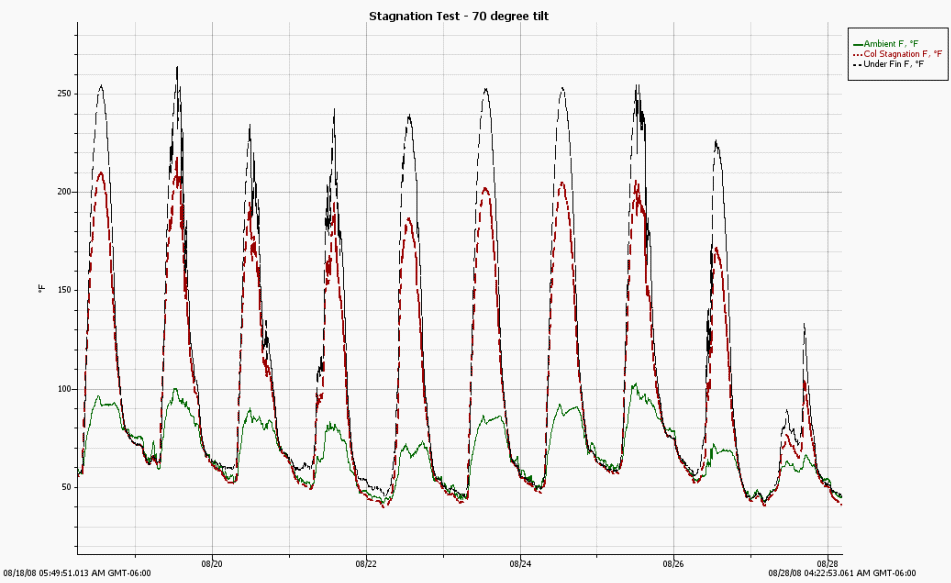
Search
The Renewable Energy site for Do-It-Yourselfers
PEX Collector
Stagnation Test
|
The plot below shows the
results of a stagnation test run on the
prototype PEX collector for several days toward the end of August.
The collector was constructed
as shown here, and was facing due south with a tilt of 70 degrees.
|
|
In solar collectors, stagnation refers to
the situation in which the sun is shining on the collector and no fluid is
flowing through the collector to remove heat. Since there is no fluid
removing heat, the collector heats up until the heat losses out the glazing
and sides and back of the collector balance the solar radiation coming into
the collector. This results in high temperatures. How high depends on the
collector construction, the glazing (single or double and transmittance,
insulation levels, and absorber construction (absorbtance and emittance),
and on the collector tilt angle.
As mentioned in the design overview,
PEX tubing will not take the kind of temperatures that occur in a collector that
is tilted to face directly into the sun during the middle of summer.
I have tilted the collector at about 70 degrees to reduce the summer heat gain
and increase the winter heat gain. This, along with a somewhat higher than
usual collector area should result in improved year round performance.
I have also avoided double glazing
and a selective coating -- both of these can increase the collector efficiency a
bit, but also raise the inside temperatures. This is not unusual --
nearly all commercial collectors are single glazed, and many do not use a
selective coating on the absorber.
Based on the data I've seen on PEX, I
would expect that it can take stagnation temperatures around 230F -- perhaps a
bit more. Since the drain back system is not pressurized, the PEX will not be
under pressure when stagnated (or any other time) -- this makes life a bit
easier.
I exposed the prototype PEX collector
to stagnation for a couple weeks in August and shorter periods at other times
during the summer. The plots below show the temperatures measured in the
collector. The collector tilt angle for these tests was 70 degrees --
lower tilt angles with more direct solar incidence would result in higher
temperatures.

The green trace shows ambient
temperature.
The red trace is the collector air
temperature near the top of the collector.
The black trace shows the temperature
registered by a K thermocouple placed between the PEX pipe and and aluminum fin.
Ambient temperatures ranged from
about 70F up to about 100F.
Collector air temperatures range up
to just over 200F on hot days.
The fin/PEX thermocouple gets to just
about 250F on hot days.
Tentative Conclusions:
- The collector would not
normally be subjected to long periods of stagnation like this. In
normal operation, the water being pumped through the collector would reduce
the collector air and PEX temperatures down into the 140F range even on hot
days. While the collector must be able to withstand some exposure to
stagnation temps, it will not be the norm.
- This seems to me to about as
high a temperature as you want to subject the PEX to for long life, so I
would be reluctant to make any design or tilt changes that would increase
stagnation temps.
- This is probably the worst time
of year for stagnation around here -- the sun is not as high in the sky as
it is in mid summer, but the ambient temps are still high -- both of these
factors raise stagnation temperatures.
- I am inclined to tentatively
conclude that the combination of high tilt angle, single glazing, and
low internal pressures of the drainback system provide enough protection
from occasional bouts of stagnation to allow a long life for the collector.
At some point, I will cut away the
fin in an area of the collector near the top, and cut open the PEX to see if it
shows any signs of distress.
Other Alternatives
If the stagnation temperatures seem
to high for comfort to you, there are some other alternatives that might work.
1 - Covering all or part of the
collector with shade cloth during the summer and early fall would cut the
temperatures down, and would probably still result in enough hot water.
A roll up shade cloth shield could be included in the collector design.
It would not have to cover all of the collector -- just enough to lower the
stagnation temperatures a few degrees.
Covering with shade cloth is
recommended by some commercial collector manufacturers for extended periods
of stagnation.
2 - Some form of venting system
that would allow a little air to flow through the collector when
temperatures rise above some level would work. One scheme for doing
this is described here...
Here is an example of a PEX collector mounted at a low tilt anlge that was damaged by overheating...
Gary August 31, 2008

